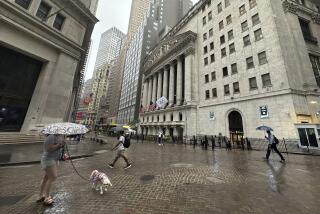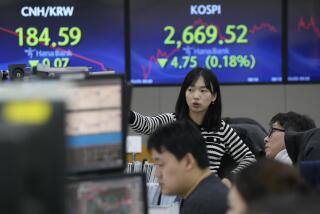It’s Not Just Asia: Blue-Chip Price-to-Risk Ratio Also Spooks Investors
Sobering statistics to ponder: Measured from last year’s peak in the Dow Jones industrial average, which was 8,259.31 on Aug. 6, through Wednesday’s close of 8,552.96, the overall price gain in those 30 blue-chip stocks works out to 3.6%.
Add in dividends, and your “total return” for the 12 months is about 5.3%.
Which is not much more than you would have earned in a virtually risk-free money market fund over the same time.
The vast majority of smaller stocks, of course, have fared even worse. The Russell 2,000 index of smaller issues is down about 1% versus its level 12 months ago.
At its heart, the sell-off that has pulled stocks lower in recent weeks tells us that investors collectively--and suddenly--decided the market had become overpriced relative to the risks involved.
Not that most of those risks weren’t apparent all along. But many investors simply chose to ignore them until, like the proverbial last straw on the camel’s back, their weight could be ignored no more.
It’s not just Asia, although as Chase Securities economist James Glassman notes, “Everything we’ve seen happen in this Asian crisis has come in on the worst side of expectations” for more than 13 months now.
There are plenty of other reasons to reconsider paying historically stratospheric price-to-earnings multiples even for the highest-quality U.S. stocks.
Russia’s ruble and banking system could yet crumble, which would have major unpleasant implications for Europe. Latin America, another big customer for U.S. exports, is seeing its stock markets hammered, which raises the risk of an economic slowdown in a region that had been expected to boom this year and into 1999.
President Clinton’s legal problems, meanwhile, are well known and, whatever investors think of him as a man, there is no percentage for the market in seeing the world’s No. 1 leader impeached.
And finally, there is the issue of U.S. corporate profits, which in aggregate are growing at their weakest pace since 1991. Here, too, it isn’t just Asia. Rising wage rates, the heavy cost of continued investment in new technology, growing competitive pressures in virtually every industry--all of these pose serious challenges to U.S. companies trying to maintain the double-digit earnings growth to which Wall Street has grown accustomed.
Perhaps it’s not a coincidence that the Securities and Exchange Commission said Wednesday that it has begun to convene meetings with chief financial officers of companies from a range of industries to discuss the recent rash of accounting debacles among major firms--Cendant, Sunbeam, Oxford Health, etc.
All have been forced to restate prior earnings because of accounting “irregularities” that made earnings look better than they actually were. What the SEC certainly is hoping not to find is that book-cooking has become rampant as companies struggle to make Wall Street happy.
Contemplating all of these risks as they relate to stock valuations, investors have taken the market down a couple of pegs. At its peak on July 17, the blue-chip Standard & Poor’s 500 index was priced at about 26 times the previous 12 months’ operating earnings (that is, earnings after one-time charges or gains).
Today, with the S&P; index down 8.6% from its peak, that P/E is just under 24. But that is still a historically high number. Which begs the question: Can blue-chip stocks really zoom again soon? What will make investors decide that paying up from these levels is a rational course of action?
Robert Brusca, economist at Nikko Securities, argues that the two great benefits of Asia’s mess--falling U.S. bond yields and falling commodity prices--won’t be viewed favorably by Wall Street if they continue in the near term, because they would suggest a looming, deflationary global recession.
Conceivably, Japan and Russia could stabilize soon, lessening the threat of a currency devaluation by China. Congress could decline to investigate Clinton any further. Investors could begin to look toward 1999 and bet on decent economic growth in most of the world, and at least a “bottom” for Asia’s crisis.
But all of those things probably need to occur--and without other bombs going off in the world--to justify significantly higher prices for many big-name stocks.
Beaten-down smaller stocks, however, may afford much more value. Even so, the market’s net gain over the last 12 months, and investors’ new wariness, may signal that the era of 30% annual returns from U.S. stocks has passed into history for good.
*
Tom Petruno’s e-mail address: [email protected].
More to Read
Inside the business of entertainment
The Wide Shot brings you news, analysis and insights on everything from streaming wars to production — and what it all means for the future.
You may occasionally receive promotional content from the Los Angeles Times.










